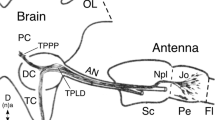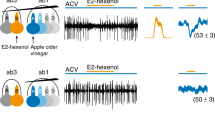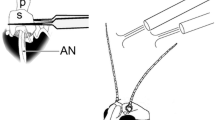Summary
Mutant first instar cockroaches (Periplaneta americana) with supernumerary filiform hair sensilla on their cerci were used to study the effects of cell body position on axonal morphology and synaptic connections. The wild-type cercus has two hairs, one lateral (L) and the other medial (M), each with an underlying sensory neuron. Silver-intensified cobalt fills show that the supernumerary lateral neuron (SIN) in the mutant has the same shape of arborization as L, and electrophysiological recording shows that it forms synaptic connections with the same subset of giant interneurons (GIs) as L in the terminal ganglion: GI3 and GI6. The supernumerary medial neuron (SuM) has the same axonal morphology as M and synapses with the same GIs as does M: ipsilateral GIs 1 and 2 and contralateral GIs 1, 2, 3, 5 and 6. In 0.1% of approximately 8000 animals screened, a supernumerary hair arose on the cereal midline (C hair). The C neuron sends its axon to the CNS in the same branch of the cereal nerve as the L and SIN, and has a similar arborization. However, the C neuron forms synapses with the same GIs as do M and SuM. Electron microscopy of horseradish peroxidase-injected neurons was used to confirm that the C afferent forms a monosynaptic connection to GI2. It was concluded that the position of the sensory neuron cell body does control its axonal morphology and synaptic connectivity, but that these characteristics are produced by independent mechanisms.
Similar content being viewed by others
Abbreviations
- GI :
-
giant interneuron
- L :
-
lateral
- M :
-
medial
- SI :
-
Space Invader
- SuM :
-
supernumerary medial
- C :
-
cereal midline
References
Bacon JP, Blagburn JM (1989) Mutant cockroach neurons compete with wild-type cells for central targets. Proc 17th Gottingen Neurotagung, Georg Thieme, Stuttgart, p 41
Bacon JP, Blagburn JM. Ectopic sensory neurons in mutant cockroaches compete with normal cells for central targets. (Submitted)
Bacon JP, Murphey RK (1984) Receptive fields of cricket giant interneurones are related to their dendritic structure. J Physiol 352:601–623
Bate CM (1973) The mechanism of the pupal gin trap. I. Segmental gradients and the triggering sensilla. J Exp Biol 59:95–107
Blagburn JM (1989) Synaptic specificity in the first instar cockroach: patterns of monosynaptic input from filiform hair afferents to giant interneurons. J Comp Physiol A 166:133–142
Blagburn JM, Bacon JP (1990) Positional information controls axon morphology and synaptic connectivity via independent mechanisms. Soc Neurosci Abstr 16:317
Blagburn JM, Sattelle DB (1987) Presynaptic depolarization mediates presynaptic inhibition at a synapse between an identified mechanosensory neurone and giant interneurone 3 in the first instar cockroach Periplaneta americana. J Exp Biol 127:135–157
Blagburn JM, Thompson KSJ (1990) Specificity of filiform hair afferent synapses onto giant interneurons in Periplaneta americana: anatomy is not a sufficient determinant. J Comp Neurol 302:255–271
Blagburn JM, Beadle DJ, Sattelle DB (1986) Differential synaptic input of filiform hair sensory neurones on to giant interneurones in the first-instar cockroach. J Insect Physiol 32:591–595
Chiba A, Shepherd D, Murphey RK (1988) Synaptic rearrangement during postembryonic development of the cricket. Science 240:901–905
Dagan D, Volman S (1982) Sensory basis for directional wind detection in first instar cockroaches, Periplaneta americana.J Comp Physiol 147:471–478
Eisen JS (1989) Soma position determines identity of primary motoneurons in developing zebrafish embryos. Soc Neurosci Abstr 15:1262
Fraser SE, O'Rourke NA (1990) In situ analysis of neuronal dynamics and positional cues in the patterning of nerve connections. J Exp Biol 153:61–70
French VI, Bryant PJ, Bryant SV (1976) Pattern regulation in epimorphic fields. Science 193:969–981
Gaze RM, Straznicky C (1980) Stable programming for map orientation in disarranged embryonic eyes in Xenopus. J Embryol Exp Morphol 55:143–165
Ghysen A (1980) The projection of sensory neurons in the central nervous system of Drosophila: choice of the appropriate pathway. Devel Biol 78 521–541
Hamon A, Guillet JC, Callec JJ (1990) A gradient of synaptic efficacy and its presynaptic basis in the cereal system of the cockroach. J Comp Physiol A 167:363–376
Kämper G, Murphey RK (1987) Synapse formation by sensory neurons after cross-species transplantation in crickets: the role of positional information. Devel Biol 122:492–502
Murphey RK, Jacklet A, Schuster L (1980) A topographic map of sensory cell terminal arborizations in the cricket CNS: correlation with birthday and position in a sensory array. J Comp Neurol 191:53–64
Murphey RK, Possidente DR, Vandervorst P, Ghysen A (1989) Compartments and the topography of leg afferent projections in Drosophila. J Neurosci 9:3209–3217
Nicklaus R (1965) Die Erregung einzelner Fadenhaare von Periplaneta americana in Abhängigkeit von der Größe und Richtung der Auslenkung. Z Vergl Physiol 50:331–362
Raper JA, Bastiani MJ, Goodman CS (1983) Pathfinding by neuronal growth cones in grasshopper embryos. II. Selective fasciculation onto specific axonal pathways. J Neurosci 3:31–41
Thompson KSJ, Blagburn JM, Gibbon CR, Bacon JP. Correlation of filiform hair position with sensory afferent morphology and synaptic connections in the second instar cockroach, (submitted)
Walthall WW, Murphey RK (1986) Positional information, compartments and the cereal sensory system of crickets. Devel Biol 113:182–200
Wolpert L (1969) Positional information and the spatial pattern of cellular differentiation. J Theor Biol 25:1–47
Author information
Authors and Affiliations
Rights and permissions
About this article
Cite this article
Blagburn, J.M., Blanco, R.E., Thompson, K.S.J. et al. Positional information determines the anatomy and synaptic specificity of cockroach filiform hair afferents using independent mechanisms. J Comp Physiol A 169, 607–614 (1991). https://doi.org/10.1007/BF00193550
Accepted:
Issue Date:
DOI: https://doi.org/10.1007/BF00193550




